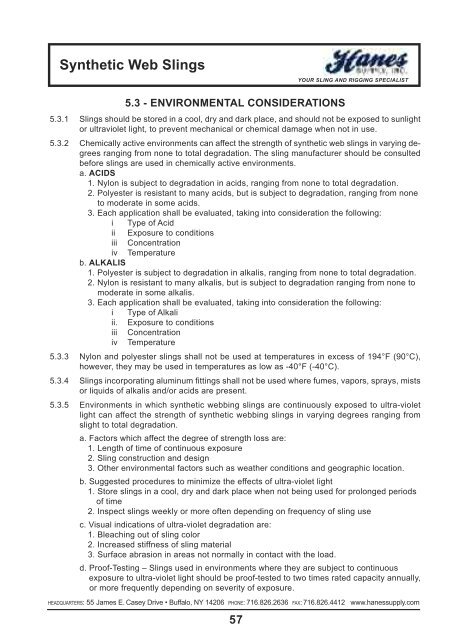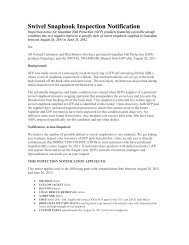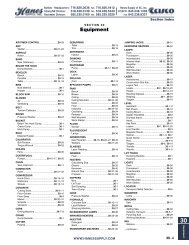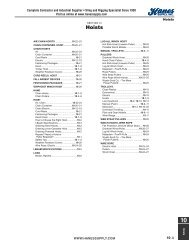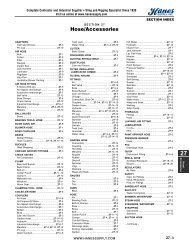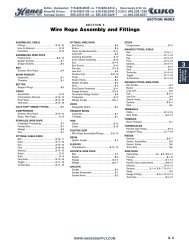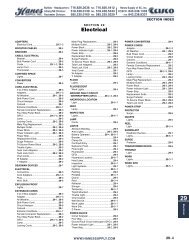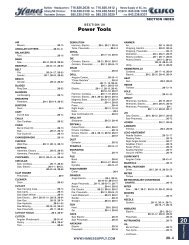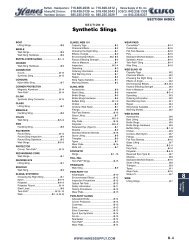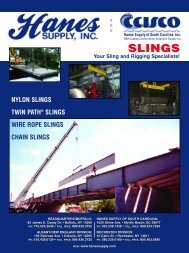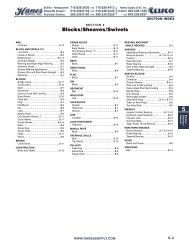twin-path® slings in action - Hanes Supply, Inc
twin-path® slings in action - Hanes Supply, Inc
twin-path® slings in action - Hanes Supply, Inc
- No tags were found...
Create successful ePaper yourself
Turn your PDF publications into a flip-book with our unique Google optimized e-Paper software.
synthetic Web <strong>sl<strong>in</strong>gs</strong>YOUR SLING AND RIGGING SPECIALIST5.3 - enVIRonMental consIDeRatIons5.3.1 Sl<strong>in</strong>gs should be stored <strong>in</strong> a cool, dry and dark place, and should not be exposed to sunlightor ultraviolet light, to prevent mechanical or chemical damage when not <strong>in</strong> use.5.3.2 Chemically active environments can affect the strength of synthetic web <strong>sl<strong>in</strong>gs</strong> <strong>in</strong> vary<strong>in</strong>g degreesrang<strong>in</strong>g from none to total degradation. The sl<strong>in</strong>g manufacturer should be consultedbefore <strong>sl<strong>in</strong>gs</strong> are used <strong>in</strong> chemically active environments.a. acIDs1. Nylon is subject to degradation <strong>in</strong> acids, rang<strong>in</strong>g from none to total degradation.2. Polyester is resistant to many acids, but is subject to degradation, rang<strong>in</strong>g from noneto moderate <strong>in</strong> some acids.3. Each application shall be evaluated, tak<strong>in</strong>g <strong>in</strong>to consideration the follow<strong>in</strong>g:i Type of Acidii Exposure to conditionsiii Concentrationiv Temperatureb. alkalIs1. Polyester is subject to degradation <strong>in</strong> alkalis, rang<strong>in</strong>g from none to total degradation.2. Nylon is resistant to many alkalis, but is subject to degradation rang<strong>in</strong>g from none tomoderate <strong>in</strong> some alkalis.3. Each application shall be evaluated, tak<strong>in</strong>g <strong>in</strong>to consideration the follow<strong>in</strong>g:i Type of Alkaliii. Exposure to conditionsiii Concentrationiv Temperature5.3.3 Nylon and polyester <strong>sl<strong>in</strong>gs</strong> shall not be used at temperatures <strong>in</strong> excess of 194°F (90°C),however, they may be used <strong>in</strong> temperatures as low as -40°F (-40°C).5.3.4 Sl<strong>in</strong>gs <strong>in</strong>corporat<strong>in</strong>g alum<strong>in</strong>um fitt<strong>in</strong>gs shall not be used where fumes, vapors, sprays, mistsor liquids of alkalis and/or acids are present.5.3.5 Environments <strong>in</strong> which synthetic webb<strong>in</strong>g <strong>sl<strong>in</strong>gs</strong> are cont<strong>in</strong>uously exposed to ultra-violetlight can affect the strength of synthetic webb<strong>in</strong>g <strong>sl<strong>in</strong>gs</strong> <strong>in</strong> vary<strong>in</strong>g degrees rang<strong>in</strong>g fromslight to total degradation.a. Factors which affect the degree of strength loss are:1. Length of time of cont<strong>in</strong>uous exposure2. Sl<strong>in</strong>g construction and design3. Other environmental factors such as weather conditions and geographic location.b. Suggested procedures to m<strong>in</strong>imize the effects of ultra-violet light1. Store <strong>sl<strong>in</strong>gs</strong> <strong>in</strong> a cool, dry and dark place when not be<strong>in</strong>g used for prolonged periodsof time2. Inspect <strong>sl<strong>in</strong>gs</strong> weekly or more often depend<strong>in</strong>g on frequency of sl<strong>in</strong>g usec. Visual <strong>in</strong>dications of ultra-violet degradation are:1. Bleach<strong>in</strong>g out of sl<strong>in</strong>g color2. <strong>Inc</strong>reased stiffness of sl<strong>in</strong>g material3. Surface abrasion <strong>in</strong> areas not normally <strong>in</strong> contact with the load.d. Proof-Test<strong>in</strong>g – Sl<strong>in</strong>gs used <strong>in</strong> environments where they are subject to cont<strong>in</strong>uousexposure to ultra-violet light should be proof-tested to two times rated capacity annually,or more frequently depend<strong>in</strong>g on severity of exposure.HEADQUARTERS: 55 James E. Casey Drive • Buffalo, NY 14206 PHONE: 716.826.2636 FAX: 716.826.4412 www.hanessupply.com57


